IN SEARCH OF THE INCA TRAIL
Being John Brown's Route Survey log
EPISODE FOUR: Days 22 to 28 (La Paz to Puno)
Day twenty-two - Friday 11 February
A day of routine housekeeping in La Paz: a very good meeting with the British Ambassador, and touching base with FEBED, the Bolivian motor sport federation, who are providing marshals and other support. Great news: Jo is flying out to join us tomorrow.
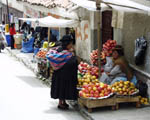
I saw this market trader in La Paz today
|
Day 23 - Saturday 12 February
Apart from the joy of meeting Jo, another essential but boring day of meetings with motor sport officials and others.
Day 24 - Sunday 13 February
We decided to drive back to Potosí, to check and backnote the direct route from there to La Paz. We were delighted to find that it provides an excellent easier option for older cars.
Going in rally direction rather than ours today, soon after Potosí there is a good gravel main road for about 130 km, through high treeless hills with some wonderful views, rising to around 14,500 ft. Here we saw lots of llama and alpaca. If Sergio Leone is looking for a set for his next spaghetti western, Cruce Ventilla is just the place - the haunting harmonica music was palpable.
For the last 45 km out to the plain, there are unpleasant road works and detours as a new asphalt highway nears completion - it will certainly be finished for the rally. Finally, 340 km of fast straight asphalt across the Altiplano lead swiftly to La Paz.
Saw a 'micro' (bus) with five live sheep tied on to its roof rack.
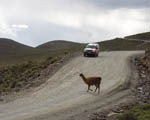
Mitzi meets llama
|
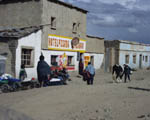
Hotel Copacabana, Cruce Ventilla - just waiting for Clint to ride in
|
Day 25 - Monday 14 February
Poor Jo had not been feeling too fit yesterday and had a bad night with altitude sickness in Potosí, the highest city on the Inca Trail route.
We had done all the wrong things: she had flown straight into La Paz airport (12,000 ft) with zero acclimatisation; she had taken no Ranitidine or other course of treatment (which should be started three days ahead) before flying out, although she did start taking it as soon as she arrived; instead of a rest, we had then submitted her immediately to a long day's drive, much of it on bumpy and dusty roads, with no meal breaks; and, most vital of all, she had not kept up her fluid intake, having had virtually nothing to drink all day (my doctor recommends 4 litres a day).
But after taking some paracetamol and drinking lots of water during the night, she felt well enough this morning for a little light shopping. She found some nice alpaca shawls in a small shop. The main market did not yield any treasures, but was fascinating to visit - even if the meat stalls need a strong stomach.
.
After that, we ran once more down the good asphalt road to Sucre, where the dose was repeated. We bought a lovely bracelet and necklace in very pure silver as a Valentine's Day present. Tonight, she quite feels her old self again.
Memo 1: get the rally doctors to issue Ranitidine three days before we go up high.
Memo 2: pass the word about the good shops.
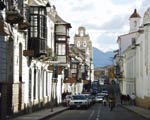
Sucre's colonial streets have some interesting shop
|
Day 26 - Tuesday 15 February
A very productive day in Sucre. The local motor club run a race meeting each 25 May (Bolivia's national day) around a 30 km circuit starting and finishing in the main square of this sizeable city, and going out through the streets to some excellent gravel sections through the surrounding hills. They take us around it for a lap, and offer to close it for the Inca Trail to have its own race.
Tempting though this offer is, duty calls. I have to explain tactfully about regularity rallies and FIA rules. However, don't be surprised if the is a rather special regularity section there next October!
In the afternoon, Klaus takes us to see a truly amazing collection of dinosaur tracks at the local cement quarry - perhaps the most extensive site in the world. Don't miss this while you're there.
Our extended stay in Sucre is rounded off by a pleasant evening at the motor club clubhouse, watching videos of their race meeting. Crowd control is still at a relatively early stage of development, but great fun is clearly had.
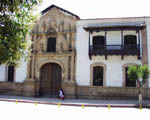
Casa de la Libertad, Sucre - start and finish line of the local race circuit
|
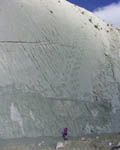
'Jingers!': Mitzi's man earns his nickname as he marvels at just a small part of Sucre's dinosaur footprints
|
Day 27 - Wednesday 16 February
We have arrived very late in La Paz (again!), having explored the shortest but toughest route from Sucre. One 65 km stretch is too rough for classics, but will make a wonderful 4x4 section through superb scenery. By next month, this will be bypassed by a new road, which is to be inaugurated by a race from one end to the other organised by our friends. This will make a good classic car route.
We made a detour back down to Maragua, the end of the new road and the race, along a wonderful but scary bit of rally route which zigzags up an almost sheer face. Maragua itself is no metropolis, either.
On this detour, we came across a tiny stone watermill grinding flour direct from a mountain stream. The miller was glad to show us round in exchange for three cigarettes - a very useful currency for thanking people; much appreciated and more dignified than money.
For another few hours we traversed some truly fantastic landscapes, mostly on good gravel but with some riverbeds which in this wet season are very rough. In March though they will be regraded for the dry season (and for the rally). One section is especially memorable, winding its way on a narrow ledge down into a gorge.
Then a final 250 km dash back to the sybaritic comfort of the Radisson La Paz on the now familiar Altiplano main road.
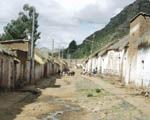
Maragua main street - part of rally route
|
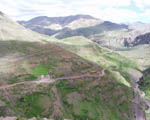
The route threads between precipitous hill farms near Maragua
|
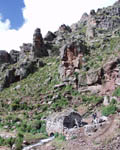
Watermill near Maragua
|
Day 28 - Thursday 17 February
A quiet and sumptuous day alongside and across Lake Titicaca. First, a quick visit to La Paz's local race circuit, where we will be holding a typical HERO lap time consistency test; then on to a short but superb regularity section along the banks of the lake.
We stop for lunch at a little waterside restaurant, and feast on freshly caught salmon trout, simply grilled. At Tiquina, we take one of the 60 two-car (or one bus!) motorised punts for the 15 minute ferry ride across a narrow part of the lake.
The drive from here to the border was stunning: a good asphalt road climbing high above the lake and offering a succession of views, each better than the last. We passed the town of Copacabana, and had a brief look at the church with its ceramic tiles, as well as the town beach - a little less glamorous than its Rio namesake!
The border crossing into Peru was painless, even without any special arrangements: 45 minutes for the lot, including spraying Mitzi with Peruvian disinfectant. I asked the man for another go as he didn't get all the mud off, but he just grinned. That won him an Inca Trail sticker.
Finally a short run to Puno along the lake in the evening sunshine. The distant snow-covered peaks across the lake in Bolivia are wonderfully lit, and look no more than a few miles away.
Our Puno hotel turns out to be on an island, with views of the lake from every room.

Lakeside reed beds as seen from the Titicaca regularity section
|

The other Copacabana Beach
|

Car ferry at Tiquina
|
|
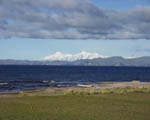
The Bolivian Cordillera Real seen across Lake Titicaca
|
|
Next: Puno to Ayacucho (to be posted Monday 20 March)













